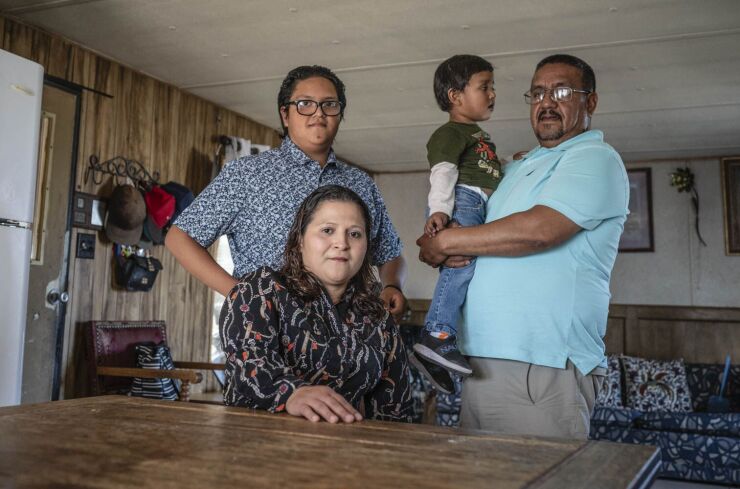The end of unprecedented pandemic-era federal benefits for families has sent U.S. child poverty rates
Eleven states have created or expanded a fully refundable child tax credit following the expiration at the end of 2021 of the federal measure, which enabled families to get as much as $3,600 per child. Those national benefits helped cut the child-poverty rate by nearly half to 5.2% in 2021, according to the Census Bureau.
But the rate

"Facing the reality of so many families still struggling due to the economic and health impacts of the pandemic, states had to step forward in big ways," said Amber Wallin, executive director of New Mexico Voices for Children, an advocacy organization.
States including New Mexico, Maryland and Minnesota have adopted some form of tax credit for families, helping to ease the burden. But even supporters point out their limitations, since they represent only a small share of Americans struggling to make ends meet. For instance, no states in the South, home to some of the highest U.S. poverty rates, offer child tax credits.
"Part of the reason why the tax credit was so valuable is that it was federal," said Joanne Samuel Goldblum, the chief executive officer of the National Diaper Bank Network, an advocacy group. "It was for everybody, and it was relatively easy to access," she added.
'I only had $6.00'
Iris Madely Alay Orozco, her husband Roberto, and their three sons live in a trailer park in Santa Fe, New Mexico. It has been hard to make ends meet since Roberto, 53, had to cut back on his workload due to health issues and Iris, 39, lost her job at a hotel.
Roberto collects water from a nearby well and buys firewood in the mountains. Iris drives 45 minutes for cheaper groceries, spending about $500 in food per month. Enhanced SNAP benefits and child tax credit helped her buy essentials like bread, toilet paper and winter clothes.
When those benefits expired, she felt helpless. She now has a job working in retail that pays her $15 an hour, but after paying the family's $800 rent, there's not much left, she said. "I didn't have anything, but I thought, 'I get paid on the 19th,' and then when I checked my account I only had $6.00," she said.
The new state program may provide a boost to her family.
Under New Mexico's expanded child tax credit, families with children under the age of 17 will be able to claim up to $600 per child. The size of the credit begins to decrease for families making more than $25,000 a year.
The expanded child tax credit is projected to provide more than $100 million in tax relief for more than 200,000 New Mexico families.
Maryland provides families with an income of $15,000 or less with a credit of $500 per child under the age of 6. Minnesota established a child tax credit this year that provides the largest amount compared to other states at up to $1,750 per child.
Not all states have made up for the expired federal aid for families with children.
In Syracuse, Kansas, pandemic-era benefits allowed Brandi Johns to loosen her belt a little. The 42-year-old used it to buy essentials, but also to get her son a bike.
With most of the additional help now gone, her 50-hour weekly shifts at Dollar General Inc. are not enough to make ends meet. Johns, her seven-year-old son and her father split rent with another family of soon-to-be four, and because she doesn't make enough to fix the bike, her boy now barely has any toys to play with.
"It's always a case of you make too much to get any assistance but you don't make enough to live," Johns said.
Long-term consequences
Both Republicans and Democrats have floated proposals to expand the federal child tax credit.
A group of House Democrats led by Representative Rosa DeLauro of Connecticut reintroduced a bill this year to restore the credit to the amounts established under the American Rescue Plan.
In July, Republican Representative John James of Missouri introduced legislation that would increase the federal child tax credit to $3,500 per child and $4,500 for children under the age of six.
In the 2017 Tax Cuts and Jobs Act, Republican lawmakers boosted it to as much as $2,000 for children 16 and under. That increase currently remains in place but will expire beginning in 2026.
"There's a lot of feeling amongst the Republican majority that we have to ease inflation for working families and meeting parents where they are," James said in an interview. "Expanding the child tax credit is something that really makes sense," he added.
Though the increase in poverty is worrisome in itself, it could also result in long-term consequences for the U.S.
Researchers at the Washington University in St. Louis
"Poverty is not just about somebody else," said Mark Rank, one of the authors of the study. "Not only is dealing with childhood poverty the right thing to do, but it's also economically the smart thing to do."





